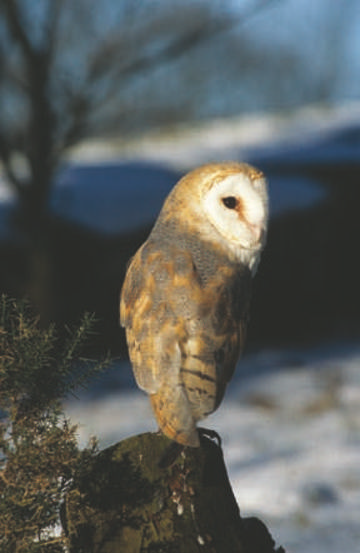
Barn Owl © Simon Booth
Adult Barn Owls rarely move far from their breeding areas, and the map shows that fieldwork for this Atlas substantially under-recorded them in winter. Apart from a few visits from members of the county’s Barn Owl Conservation Groups, most birds were found by chance. They give few clues, seldom calling in winter, and not eliciting as much mobbing by small birds as other owls and raptors do (Bunn et al 1982). Birds can appear to be secretive, mainly seen unexpectedly when a ghostly bird floats silently past, the paler males especially seeming to be almost white. Although mostly nocturnal, they may often be found active during daylight, especially after a period of wet weather, because they try to avoid hunting in the rain, and have reduced success in high winds. Surveyors saw birds hunting near roads in several tetrads. At Davenham (SJ67Q) their presence was proven with a bird found freshly dead on road, but, more happily, the records in SJ88R came courtesy of Wilmslow Police, whose officers several times saw a Barn Owl from their patrol cars.
The winter map shows birds present in just 105 tetrads, 39 of them in which Barn Owls were not recorded during the breeding season, but they were not reported from 149 tetrads that were occupied for breeding. They would be expected to have a wider distribution in winter than during the breeding season. Individual birds cover more ground, increasing their typical hunting range from 1-2 km to 4-5 km, and dispersing first-year birds wander about until they can find a territory and a mate for themselves. Ringed chicks typically seem to settle to breed about 5 or 6 km from their natal site.
Of the 133 habitat records submitted, 92 were farmland (69%), with more unimproved grassland (28) than improved grassland (26) indicating their preference for uncultivated land. 24 were recorded as human sites, with 7 semi-natural grassland. Barn Owls’ diet, easily examined by analysis of their pellets, inevitably follows the seasonal availability of their prey. Field Voles peak in late autumn, perfect for the inexperienced young owls attempting to fend for themselves. Wood Mice numbers are at their highest during early winter. Shrews tend to reach maximum numbers in mid-summer and rapidly die off in autumn, but they are especially susceptible to Barn Owls during winter and early spring because, eating live prey of insects and invertebrates, they have to remain active and presumably quite visible (Shawyer 1998). Whatever the species of mammal, Barn Owls preferentially go for the largest males in the prey population (Taylor 1994). As well as rain and strong winds, any periods of prolonged snow cover make hunting particularly difficult for them as their targets are hidden, but it is some years since Cheshire experienced such conditions. As a southern species here at the northern limit of its cosmopolitan distribution, Barn Owls can suffer badly in severe winter weather.
Most birds were found singly, with just eight records of more than one bird, several time attributed by observers to family parties. Although this map is for our defined winter period, some Barn Owls are still breeding late in the year and may have a second brood still in their nest; the chicks fledged from one Wirral nestbox in the last week of December in 2004.
Dedicated by the Cheshire Barn Owl Groups to the memory of George Bramall, founder of the Broxton Barn Owl Group and inspiration to the founding of other Barn Owl groups in Cheshire.

